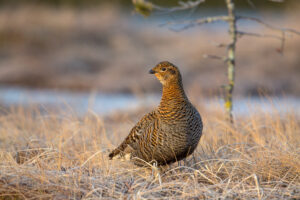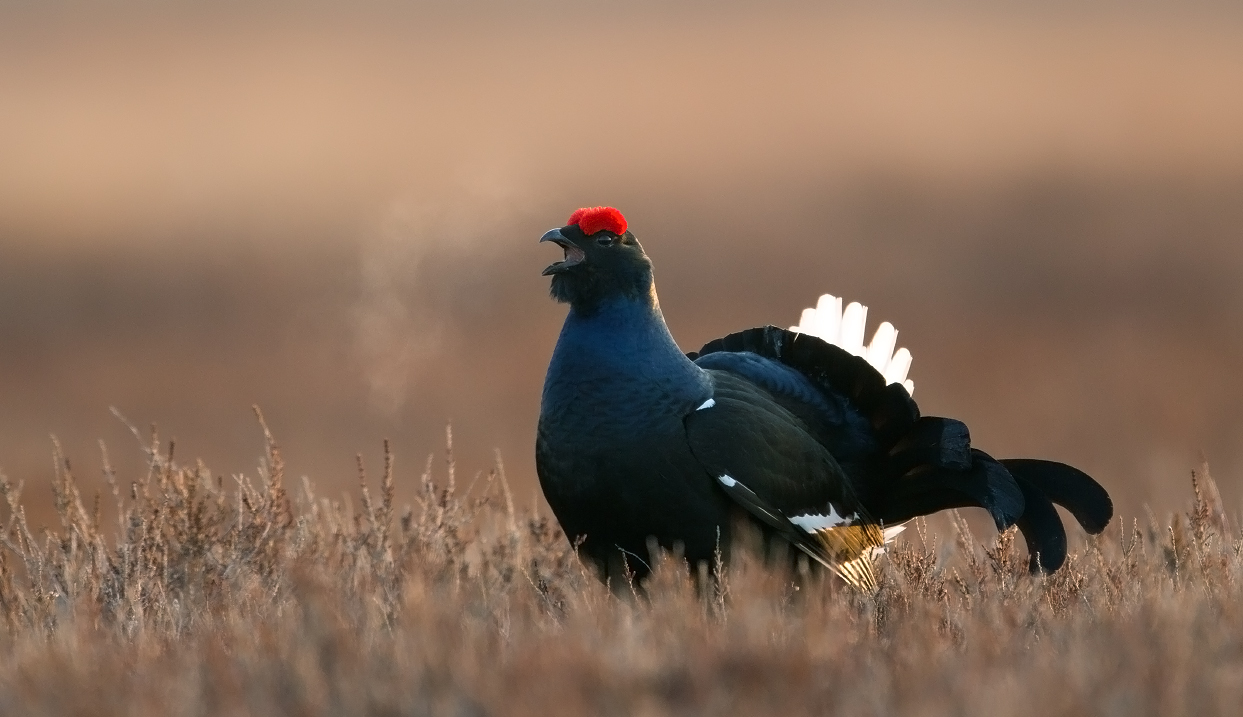Black grouse
- Black grouse, Mägestikupalu
- https://linnuriik.ee/wp-content/uploads/2021/09/teder-emane-tammik-1024x683.jpg
- Keemu linnud
- https://linnuriik.ee/wp-content/uploads/2021/09/07_Teder_091011aa090126_Magestikupalu.mp3
Male black grouse. Photo: Lauri Tammik
Introduction
Latin Tetrao tetrix L.
Estonian Teder
Also known as: Northern black grouse, Eurasian black grouse, blackgame or blackcock
Status in Estonia
Breeding and wintering bird.
Description
The black grouse is a medium-sized land fowl with a small head and beak. The male bird is black with a purple shine, while the undertail, underwing and wing stripe are white. It has striking red ‘eyebrows’. The lyre-shaped tail is upright during courtship ritual but is narrow and appears long when in flight. Female birds are greyish-brown with dark stripes all over and their tails are also greyish-brown with a slight rust-coloured tint.
Size
Male body length 49–58 cm (incl. tail approx. 10 cm), female body length 40–45 cm, wingspan 65–80 cm, male body mass 1.2–1.3 kg, female body mass 0.9–1 kg.

Similar species
Western capercaillie
Distribution
The distribution area is throughout Eurasia, overlapping extensively with the temperate climate zone. Most of it is in the forest and forest steppe zones. The distribution area is from Norway, France and Great Britain in the West to approximately Vladivostok in the Far East. Only isolated small populations have persisted in Central Europe; the species is extinct in Croatia, Hungary, Turkey and most likely in Serbia and Montenegro as well. It has been introduced to Canada and the United States. The black grouse is widespread in Estonia but is an uncommon breeding bird.
Population
Estonia has 4000–5000 breeding pairs.
Occurrence in Estonia
Sedentary bird.
Diet
It feeds on birch catkins, birch shoots, buds, berries and various herbaceous plants. Initially, the young only eat insects.
Habitat
It changes habitat based on its life cycle. Its nesting habitats include fens, transitional bogs, shrubs and forest edges. In the winter, adequate feeding and shelter conditions are critical, both for sleeping and in the case of adverse weather conditions. The feeding habitats are mostly dependent on the presence of birch stands; smaller groves in more exposed biotopes and the edges of mixed or birch forests next to open landscapes are preferred. In spring, grouse typically breed in bogs and raised bogs as well as fields and meadows at the edge of forests where disturbance is minimal.
Nesting
The males have a very distinctive courtship ritual during spring. The weather determines when the courtship ritual season begins, which ranges from early March to April each year. During the courtship ritual, each male bird has a designated place on the field according to his position in the hierarchy. The ‘best’ birds are in the middle of the field, the worst ones are on the outskirts. The courtship ritual ends in May. The nest hole is scraped into the earth in a hidden location, sometimes under old grass or under the shade of bushes. In early May, the female lays 7–10 cream-coloured eggs with dark brown spots, which she incubates for 19–28 days. Chicks are nidifugous and can fly by the end of their second week of life.
Conservation status and protection
It belongs to the protected species of category III. The most serious threats are habitat destruction or degradation. Large-scale drainage projects have a negative impact on habitats, as does the forest’s subsoil, which has been degraded by heavy forestry equipment. The large number of predators and wild boars and disturbances at the nest have a negative impact on the species because the black grouse nests on the ground and the eggs and newly hatched chicks are vulnerable to the cold. During the first three weeks, the chicks have not yet developed thermoregulation and the adult bird must keep them warm. Unfavourable weather conditions can also be a threat to the black grouse.
Distribution and population in Lääne County
The black grouse is an uncommon species of land fowl found in the bogs and bog meadows of Lääne County. The black grouse can also be spotted in Matsalu National Park, where they frequent the meadow and eat juniper berries.
Grouse can be found in Lääne County near the Tuhu Bog, while in Matsalu, they are more visible from the Rannajõe Observation Platform.
